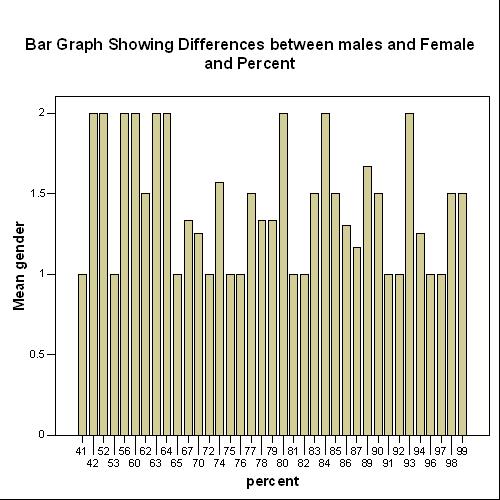Introduction
The main objective of this exercise is to use two sets of data; smoking 1.sav and grades 2.sav to develop and test hypothesis. The data will be used separately to answer three different questions. Ideally independent samples T-test is used when one wish to determine whether the difference between means for two sets of scores is significant. Dependent variable will be carried out in part two. It is worth noting that the type of data used as test variable should be interval or ratio while the grouping variable is categorical.
Using Grades2.sav
Section 1
The variables to be used in this case are gender as the grouping variable and percent as test variable.
Hypotheses:
- H0: The gender of an individual influences the grade obtained.
- H1: The gender of an individual does not influence the grade obtained.
It is my assumption that females due to the fact that they have more household responsibilities than their male counterparts, they have less time to do personal studies at home. For this reason, they will have lower grades compared to male students.
Table 1: Group Statistics
Table 2: Independent Samples Test
An independent sample t-test was undertaken to determine whether there was a significant mean difference in the grade in terms of percent between males and females. The results from the analysis indicates that there was no statistical significance, (t=1.220, DF=73.365, p=0.226). However the finding shows that the mean for male was 81.55 while that of the female was 78.46. This means that more male got slightly higher percents that female. This may mean that there are other factors that determine the percent one gets. To this end, the hypothesis that “The gender of an individual influences the percent obtained” is not supported and thus I fail to accept it.
Based on this result I can conclude that the gender of individual does not influence the percent one gets in tests. There might be other factors other than gender that dictates what one gets in terms of percent.

From figure 1 it is evident that there were differences in percent based on the gender.
Section 2
The hypothesis to be tested;
- H0: Those with (prevgpa) >= 2.72 had higher percent
- H1: Those with (prevgpa) >= 2.72 did not have higher percent
Table 3: Group Statistics
From Table 3 the number of respondents having prevgpa >= 2.72 was 53 while those whose prevgpa was less than 2.72 were 52 with a mean and standard deviation of 84.53, 76.08 and 12.266, 10.495 respectively. From the independent sample t-test carried to determine whether having (prevgpa) of equal or greater than 2.72 had higher percent, the findings indicate that there was a statistical differences (t = 3.796, DF=101.140, p =.000). This suggests (Table 4) that those with prevgpa >= 2.72 had higher percent (mean=84.53) compared to those who had prevgpa < 2.72 (mean=76.08). This thus supports the hypothesis meaning that having a prevgpa >= 2.72 one will have higher percent.
Table 4: Independent Samples Test
Using Smoking [1].sav
The data smoking [1].sav was used to evaluate the alternative hypothesis that people smoked less often after using Nicoterm gum. This is accomplished by using dependent or paired-sample t-test which is used when one has data set obtained from one group of participants.
Table 5: Paired Samples Statistics
From table 5 there are 76 people who responded to the question regarding smoking less after using Nicoterm gum. The same number of control group responded to the same question. The standard deviation stood at 0.501 and 4.416 in that order
Table 6: Paired Samples Correlations
The correlation table 4 shows that r=0.067 and p=0.567. This tells us that we can fail to reject the null hypothesis.
Table 7: Paired Samples Test
Table 7 provides us with the inferential statistics. In this sample of 76 participants, the mean response for stopping smoking after using Nicoterm gum was higher for the control group (mean=8.736) than the mean for treatment group (mean=0.553). The differences is significant (t=16.174, DF=75, p=0.000). This means that respondents smoked less often after using Nicoterm gum. Thus the alternative hypothesis is supported.
Hypothesis testing involves the following steps:
- Stating the research question.
- Specifying the null and alternative hypotheses.
- Calculating test statistic.
- Calculating probability of test statistic.
- Stating the conclusion.